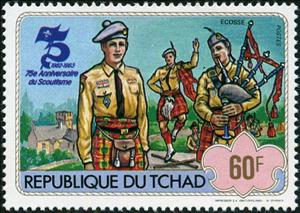Stamp: 75th Anniversary of Scouting (Chad 1982)
75th Anniversary of Scouting (Chad 1982)
01 January (Chad ) within release Scouting goes into circulation Stamp 75th Anniversary of Scouting face value 60 Central African CFA franc
| Stamp 75th Anniversary of Scouting in catalogues | |
|---|---|
| Michel: | Mi:TD 911 |
| Yvert et Tellier: | Yt:TD 399 |
Stamp is square format.
Also in the issue Scouting:
- Stamp - 75th Anniversary of Scouting face value 30;
- Stamp - 75th Anniversary of Scouting face value 40;
- Stamp - 75th Anniversary of Scouting face value 50;
- Stamp - 75th Anniversary of Scouting face value 60;
|
Data entry completed
46%
|
|
|---|---|
| Stamp 75th Anniversary of Scouting in digits | |
| Country: | Chad |
| Date: | 1982-01-01 |
| Perforation: | 13¼ |
| Format: | Stamp |
| Face Value: | 60 Central African CFA franc |
Stamp 75th Anniversary of Scouting it reflects the thematic directions:
Music is an art form and cultural activity whose medium is sound organized in time. The common elements of music are pitch (which governs melody and harmony), rhythm (and its associated concepts tempo, meter, and articulation), dynamics (loudness and softness), and the sonic qualities of timbre and texture (which are sometimes termed the "color" of a musical sound). Different styles or types of music may emphasize, de-emphasize or omit some of these elements. Music is performed with a vast range of instruments and vocal techniques ranging from singing to rapping; there are solely instrumental pieces, solely vocal pieces (such as songs without instrumental accompaniment) and pieces that combine singing and instruments. The word derives from Greek μουσική (mousike; "art of the Muses"). In its most general form, the activities describing music as an art form or cultural activity include the creation of works of music (songs, tunes, symphonies, and so on), the criticism of music, the study of the history of music, and the aesthetic examination of music. Ancient Greek and Indian philosophers defined music as tones ordered horizontally as melodies and vertically as harmonies. Common sayings such as "the harmony of the spheres" and "it is music to my ears" point to the notion that music is often ordered and pleasant to listen to.
A musical instrument is a device created or adapted to make musical sounds. In principle, any object that produces sound can be considered a musical instrument—it is through purpose that the object becomes a musical instrument. A person who plays a musical instrument is known as an instrumentalist. The history of musical instruments dates to the beginnings of human culture. Early musical instruments may have been used for rituals, such as a horn to signal success on the hunt, or a drum in a religious ceremony. Cultures eventually developed composition and performance of melodies for entertainment. Musical instruments evolved in step with changing applications and technologies.
Scouting, also known as the Scout Movement, is a worldwide youth social movement employing the Scout method. It is a program of informal education with an emphasis on practical outdoor activities, including camping, woodcraft, aquatics, hiking, backpacking, and sports. Another widely recognized movement characteristic is the Scout uniform, by intent hiding all differences of social standing in a country and encouraging equality, with neckerchief and campaign hat or comparable headwear. Distinctive uniform insignia include the fleur-de-lis and the trefoil, as well as merit badges and other patches.
Dance is an art form, often classified as a sport, consisting of sequences of body movements with aesthetic and often symbolic value, either improvised or purposefully selected. Dance can be categorized and described by its choreography, by its repertoire of movements or by its historical period or place of origin. Dance is typically performed with musical accompaniment, and sometimes with the dancer simultaneously using a musical instrument themselves.



